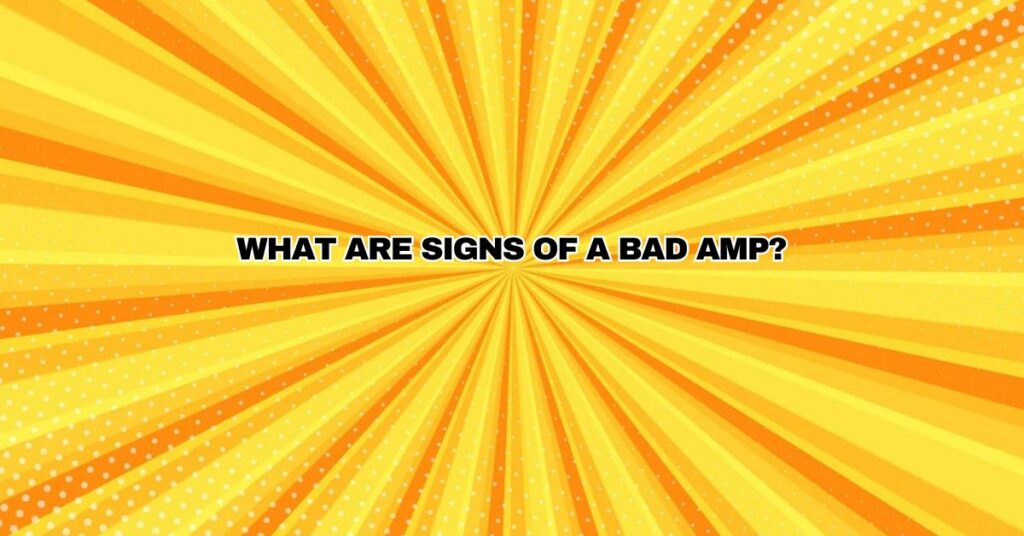Your guitar amplifier is a crucial component of your musical setup, responsible for shaping the tone and projecting your guitar’s sound. However, like any piece of electronic equipment, amplifiers can develop issues over time. Recognizing the signs of a bad amp is vital for maintaining your gear’s functionality and ensuring the best possible sound quality. In this article, we’ll explore common signs of a bad amplifier and what they may indicate in terms of problems and solutions.
1. Unusual Noise:
One of the most immediate signs of a bad amp is the presence of unusual or persistent noise. This can manifest in various forms, including:
- Hiss and Static: While a certain level of background hiss is normal in amplifiers, an excessive and persistent hissing or static noise can be a sign of problems with internal components.
- Hum: A constant low-frequency hum can be indicative of grounding issues, power supply problems, or a malfunctioning transformer.
- Crackling or Popping: Intermittent crackling or popping sounds, especially when adjusting controls or plugging and unplugging cables, may point to dirty or damaged potentiometers (knobs) or loose connections.
- Feedback: Excessive feedback, especially at low volumes, can be a sign of a bad amplifier or improper settings.
2. Inconsistent Volume or Tone:
A change in your amp’s volume or tone that can’t be attributed to your playing, guitar, or settings may indicate an issue. This includes:
- Volume Fluctuations: If your amp’s volume suddenly drops or increases without any changes to your guitar or settings, it could be related to internal component issues or a faulty potentiometer.
- Tone Changes: Significant changes in your amp’s tone, such as a loss of clarity or altered EQ characteristics, might be due to issues with the amplifier’s tubes, capacitors, or other components.
3. Excessive Heat:
Amplifiers generate heat during operation, but excessive or abnormal heat buildup can indicate a problem. If your amp feels hotter than usual or begins to emit a burning smell, it’s a sign that the internal components may be overheating or malfunctioning. In such cases, it’s crucial to turn off the amp and have it inspected by a professional technician.
4. Tube Issues:
Amplifiers that use vacuum tubes (valves) may exhibit specific signs when the tubes are failing or need replacement:
- Tube Redplating: Redplating is a phenomenon where the tube’s plate glows red, indicating excessive current. This is a sign of tube failure and should be addressed promptly.
- Microphonics: Microphonic tubes pick up and amplify external vibrations or sounds. If you hear unusual feedback or ringing from the amp when you tap or lightly touch the tubes, it could indicate microphonic tubes.
- Diminished Sound Quality: Tubes that are nearing the end of their lifespan can lead to a decrease in sound quality, clarity, and overall performance.
5. Connectivity Issues:
Faulty or loose connections in your amplifier can lead to various problems, such as:
- Intermittent Sound: If your amp’s sound cuts in and out, it may be due to loose cable connections, input jacks, or solder joints.
- No Sound: A complete absence of sound is a clear indication of a problem, and it can result from issues with internal components, fuses, or the speaker.
6. Unresponsive Controls:
Controls like knobs and switches that don’t function as expected can be a sign of a bad amp:
- Scratchy or Non-Responsive Knobs: If your amp’s knobs feel scratchy when turned or fail to adjust the settings as they should, it may point to dirty or damaged potentiometers.
7. Smoke or Burning Smells:
The appearance of smoke or a burning odor from your amplifier is a severe sign of a problem. This could indicate electrical issues or components that are overheating and potentially dangerous.
8. On/Off Problems:
Difficulty turning your amplifier on or off, such as the power switch failing to function or the amp not powering up at all, suggests electrical problems or issues with the power supply.
9. Visual Damage:
Visible signs of damage, including cracked circuit boards, loose wires, or burned components, are clear indicators of a problem. Physical damage may result from mishandling, accidents, or issues within the amplifier.
10. Age and Regular Maintenance:
Lastly, the age of your amplifier and the maintenance it has received can also impact its performance. Older amplifiers may naturally exhibit signs of wear and tear, while regular maintenance can help extend an amp’s lifespan and reliability.
In conclusion, recognizing the signs of a bad amp is crucial for maintaining the health and performance of your equipment. While some issues may be resolved with basic maintenance or minor repairs, others may necessitate the expertise of a professional amplifier technician. Regular inspection and care for your amplifier can help prevent serious problems and ensure that it continues to deliver the best possible sound for your musical endeavors.


